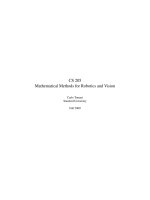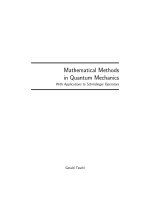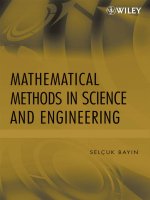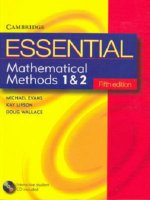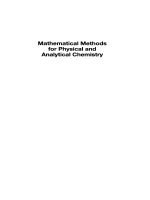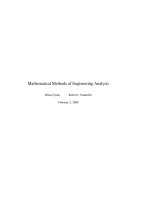- Trang chủ >>
- Khoa Học Tự Nhiên >>
- Vật lý
Mathematical methods physical sciences 3e by mary boas
Bạn đang xem bản rút gọn của tài liệu. Xem và tải ngay bản đầy đủ của tài liệu tại đây (7.03 MB, 930 trang )
MATHEMATICAL METHODS IN
THE PHYSICAL SCIENCES
Third Edition
MARY L. BOAS
DePaul University
www.pdfgrip.com
MATHEMATICAL METHODS IN THE
PHYSICAL SCIENCES
www.pdfgrip.com
www.pdfgrip.com
MATHEMATICAL METHODS IN
THE PHYSICAL SCIENCES
Third Edition
MARY L. BOAS
DePaul University
www.pdfgrip.com
PUBLISHER
SENIOR ACQUISITIONS Editor
PRODUCTION MANAGER
PRODUCTION EDITOR
MARKETING MANAGER
SENIOR DESIGNER
EDITORIAL ASSISTANT
PRODUCTION MANAGER
Kaye Pace
Stuart Johnson
Pam Kennedy
Sarah Wolfman-Robichaud
Amanda Wygal
Dawn Stanley
Krista Jarmas/Alyson Rentrop
Jan Fisher/Publication Services
This book was set in 10/12 Computer Modern by Publication Services and printed and bound by
R.R. Donnelley-Willard. The cover was printed by Lehigh Press.
This book is printed on acid free paper.
Copyright 2006 John Wiley & Sons, Inc. All rights reserved. No part of this publication may
be reproduced, stored in a retrieval system or transmitted in any form or by any means,
electronic, mechanical, photocopying, recording, scanning, or otherwise, except as permitted
under Sections 107 or 108 of the 1976 United States Copyright Act, without either the prior
written permission of the Publisher, or authorization through payment of the appropriate
per-copy fee to the Copyright Clearance Center, Inc., 222 Rosewood Drive, Danvers, MA 01923,
(978)750-8400, fax (978)750-4470 or on the web at www.copyright.com. Requests to the
Publisher for permission should be addressed to the Permissions Department, John Wiley &
Sons, Inc., 111 River Street, Hoboken, NJ 07030-5774, (201)748-6011, fax (201)748-6008, or
online at />To order books or for customer service please, call 1-800-CALL WILEY (225-5945).
ISBN 0-471-19826-9
ISBN-13 978-0-471-19826-0
ISBN-WIE 0-471-36580-7
ISBN-WIE-13 978-0-471-36580-8
Printed in the United States of America
10 9 8 7 6 5 4 3 2 1
www.pdfgrip.com
To the memory of RPB
www.pdfgrip.com
www.pdfgrip.com
PREFACE
This book is particularly intended for the student with a year (or a year and a half)
of calculus who wants to develop, in a short time, a basic competence in each of the
many areas of mathematics needed in junior to senior-graduate courses in physics,
chemistry, and engineering. Thus it is intended to be accessible to sophomores (or
freshmen with AP calculus from high school). It may also be used effectively by
a more advanced student to review half-forgotten topics or learn new ones, either
by independent study or in a class. Although the book was written especially
for students of the physical sciences, students in any field (say mathematics or
mathematics for teaching) may find it useful to survey many topics or to obtain
some knowledge of areas they do not have time to study in depth. Since theorems
are stated carefully, such students should not need to unlearn anything in their later
work.
The question of proper mathematical training for students in the physical sciences is of concern to both mathematicians and those who use mathematics in applications. Some instructors may feel that if students are going to study mathematics
at all, they should study it in careful and thorough detail. For the undergraduate physics, chemistry, or engineering student, this means either (1) learning more
mathematics than a mathematics major or (2) learning a few areas of mathematics
thoroughly and the others only from snatches in science courses. The second alternative is often advocated; let me say why I think it is unsatisfactory. It is certainly
true that motivation is increased by the immediate application of a mathematical
technique, but there are a number of disadvantages:
1. The discussion of the mathematics is apt to be sketchy since that is not the
primary concern.
2. Students are faced simultaneously with learning a new mathematical method
and applying it to an area of science that is also new to them. Frequently the
vii
www.pdfgrip.com
viii
Preface
difficulty in comprehending the new scientific area lies more in the distraction
caused by poorly understood mathematics than it does in the new scientific ideas.
3. Students may meet what is actually the same mathematical principle in two
different science courses without recognizing the connection, or even learn apparently contradictory theorems in the two courses! For example, in thermodynamics students learn that the integral of an exact differential around a closed
2π
path is always zero. In electricity or hydrodynamics, they run into 0 dθ, which
is certainly the integral of an exact differential around a closed path but is not
equal to zero!
Now it would be fine if every science student could take the separate mathematics
courses in differential equations (ordinary and partial), advanced calculus, linear
algebra, vector and tensor analysis, complex variables, Fourier series, probability,
calculus of variations, special functions, and so on. However, most science students
have neither the time nor the inclination to study that much mathematics, yet they
are constantly hampered in their science courses for lack of the basic techniques of
these subjects. It is the intent of this book to give these students enough background
in each of the needed areas so that they can cope successfully with junior, senior,
and beginning graduate courses in the physical sciences. I hope, also, that some
students will be sufficiently intrigued by one or more of the fields of mathematics
to pursue it futher.
It is clear that something must be omitted if so many topics are to be compressed
into one course. I believe that two things can be left out without serious harm at
this stage of a student’s work: generality, and detailed proofs. Stating and proving
a theorem in its most general form is important to the mathematician and to the
advanced student, but it is often unnecessary and may be confusing to the more
elementary student. This is not in the least to say that science students have no
use for careful mathematics. Scientists, even more than pure mathematicians, need
careful statements of the limits of applicability of mathematical processes so that
they can use them with confidence without having to supply proof of their validity.
Consequently I have endeavored to give accurate statements of the needed theorems,
although often for special cases or without proof. Interested students can easily find
more detail in textbooks in the special fields.
Mathematical physics texts at the senior-graduate level are able to assume a
degree of mathematical sophistication and knowledge of advanced physics not yet
attained by students at the sophomore level. Yet such students, if given simple and
clear explanations, can readily master the techniques we cover in this text. (They
not only can, but will have to in one way or another, if they are going to pass
their junior and senior physics courses!) These students are not ready for detailed
applications—these they will get in their science courses—but they do need and
want to be given some idea of the use of the methods they are studying, and some
simple applications. This I have tried to do for each new topic.
For those of you familiar with the second edition, let me outline the changes for
the third:
1. Prompted by several requests for matrix diagonalization in Chapter 3, I have
moved the first part of Chapter 10 to Chapter 3 and then have amplified the
treatment of tensors in Chapter 10. I have also changed Chapter 3 to include
more detail about linear vector spaces and then have continued the discussion of
basis functions in Chapter 7 (Fourier series), Chapter 8 (Differential equations),
www.pdfgrip.com
Preface
ix
Chapter 12 (Series solutions) and Chapter 13 (Partial differential equations).
2. Again, prompted by several requests, I have moved Fourier integrals back to the
Fourier series Chapter 7. Since this breaks up the integral transforms chapter
(old Chapter 15), I decided to abandon that chapter and move the Laplace
transform and Dirac delta function material back to the ordinary differential
equations Chapter 8. I have also amplified the treatment of the delta function.
3. The Probability chapter (old Chapter 16) now becomes Chapter 15. Here I have
changed the title to Probability and Statistics, and have revised the latter part
of the chapter to emphasize its purpose, namely to clarify for students the theory
behind the rules they learn for handling experimental data.
4. The very rapid development of technological aids to computation poses a steady
question for instructors as to their best use. Without selecting any particular
Computer Algebra System, I have simply tried for each topic to point out to
students both the usefulness and the pitfalls of computer use. (Please see my
comments at the end of ”To the Student” just ahead.)
The material in the text is so arranged that students who study the chapters
in order will have the necessary background at each stage. However, it is not
always either necessary or desirable to follow the text order. Let me suggest some
rearrangements I have found useful. If students have previously studied the material
in any of chapters 1, 3, 4, 5, 6, or 8 (in such courses as second-year calculus,
differential equations, linear algebra), then the corresponding chapter(s) could be
omitted, used for reference, or, preferably, be reviewed briefly with emphasis on
problem solving. Students may know Taylor’s theorem, for example, but have little
skill in using series approximations; they may know the theory of multiple integrals,
but find it difficult to set up a double integral for the moment of inertia of a spherical
shell; they may know existence theorems for differential equations, but have little
skill in solving, say, y + y = x sin x. Problem solving is the essential core of a
course on Mathematical Methods.
After Chapters 7 (Fourier Series) and 8 (Ordinary Differential Equations) I like
to cover the first four sections of Chapter 13 (Partial Differential Equations). This
gives students an introduction to Partial Differential Equations but requires only the
use of Fourier series expansions. Later on, after studying Chapter 12, students can
return to complete Chapter 13. Chapter 15 (Probability and Statistics) is almost
independent of the rest of the text; I have covered this material anywhere from the
beginning to the end of a one-year course.
It has been gratifying to hear the enthusiastic responses to the first two editions,
and I hope that this third edition will prove even more useful. I want to thank many
readers for helpful suggestions and I will appreciate any further comments. If you
find misprints, please send them to me at I also want to thank
the University of Washington physics students who were my LATEX typists: Toshiko
Asai, Jeff Sherman, and Jeffrey Frasca. And I especially want to thank my son,
Harold P. Boas, both for mathematical consultations, and for his expert help with
LATEX problems.
Instructors who have adopted the book for a class should consult the publisher
about an Instructor’s Answer Book, and about a list correlating 2nd and 3rd edition
problem numbers for problems which appear in both editions.
Mary L. Boas
www.pdfgrip.com
www.pdfgrip.com
TO THE STUDENT
As you start each topic in this book, you will no doubt wonder and ask “Just why
should I study this subject and what use does it have in applications?” There is a
story about a young mathematics instructor who asked an older professor “What do
you say when students ask about the practical applications of some mathematical
topic?” The experienced professor said “I tell them!” This text tries to follow
that advice. However, you must on your part be reasonable in your request. It
is not possible in one book or course to cover both the mathematical methods
and very many detailed applications of them. You will have to be content with
some information as to the areas of application of each topic and some of the
simpler applications. In your later courses, you will then use these techniques in
more advanced applications. At that point you can concentrate on the physical
application instead of being distracted by learning new mathematical methods.
One point about your study of this material cannot be emphasized too strongly:
To use mathematics effectively in applications, you need not just knowledge but skill.
Skill can be obtained only through practice. You can obtain a certain superficial
knowledge of mathematics by listening to lectures, but you cannot obtain skill this
way. How many students have I heard say “It looks so easy when you do it,” or “I
understand it but I can’t do the problems!” Such statements show lack of practice
and consequent lack of skill. The only way to develop the skill necessary to use this
material in your later courses is to practice by solving many problems. Always study
with pencil and paper at hand. Don’t just read through a solved problem—try to
do it yourself! Then solve some similar ones from the problem set for that section,
xi
www.pdfgrip.com
xii
To the Student
trying to choose the most appropriate method from the solved examples. See the
Answers to Selected Problems and check your answers to any problems listed there.
If you meet an unfamiliar term, look for it in the Index (or in a dictionary if it is
nontechnical).
My students tell me that one of my most frequent comments to them is “You’re
working too hard.” There is no merit in spending hours producing a solution to
a problem that can be done by a better method in a few minutes. Please ignore
anyone who disparages problem-solving techniques as “tricks” or “shortcuts.” You
will find that the more able you are to choose effective methods of solving problems
in your science courses, the easier it will be for you to master new material. But
this means practice, practice, practice! The only way to learn to solve problems is
to solve problems. In this text, you will find both drill problems and harder, more
challenging problems. You should not feel satisfied with your study of a chapter
until you can solve a reasonable number of these problems.
You may be thinking “I don’t really need to study this—my computer will solve
all these problems for me.” Now Computer Algebra Systems are wonderful—as you
know, they save you a lot of laborious calculation and quickly plot graphs which
clarify a problem. But a computer is a tool; you are the one in charge. A very
perceptive student recently said to me (about the use of a computer for a special
project): “First you learn how to do it; then you see what the computer can do
to make it easier.” Quite so! A very effective way to study a new technique is to
do some simple problems by hand in order to understand the process, and compare
your results with a computer solution. You will then be better able to use the
method to set up and solve similar more complicated applied problems in your
advanced courses. So, in one problem set after another, I will remind you that the
point of solving some simple problems is not to get an answer (which a computer
will easily supply) but rather to learn the ideas and techniques which will be so
useful in your later courses.
M. L. B.
www.pdfgrip.com
CONTENTS
1
INFINITE SERIES, POWER SERIES
1.
2.
3.
4.
5.
6.
7.
8.
9.
10.
11.
12.
13.
The Geometric Series
1
Definitions and Notation
4
Applications of Series
6
Convergent and Divergent Series
6
Testing Series for Convergence; the Preliminary Test
9
Convergence Tests for Series of Positive Terms: Absolute Convergence
A. The Comparison Test
10
B. The Integral Test
11
C. The Ratio Test
13
D. A Special Comparison Test
15
Alternating Series
17
Conditionally Convergent Series
18
Useful Facts About Series
19
Power Series; Interval of Convergence
20
Theorems About Power Series
23
Expanding Functions in Power Series
23
Techniques for Obtaining Power Series Expansions
25
A. Multiplying a Series by a Polynomial or by Another Series
26
B. Division of Two Series or of a Series by a Polynomial
27
xiii
www.pdfgrip.com
1
10
xiv
14.
15.
16.
2
Contents
C. Binomial Series
28
D. Substitution of a Polynomial or a Series for the Variable in Another
Series
29
E. Combination of Methods
30
F. Taylor Series Using the Basic Maclaurin Series
30
G. Using a Computer
31
Accuracy of Series Approximations
33
Some Uses of Series
36
Miscellaneous Problems
44
COMPLEX NUMBERS
1.
2.
3.
4.
5.
6.
7.
8.
9.
10.
11.
12.
13.
14.
15.
16.
17.
3
1.
2.
3.
4.
5.
6.
7.
8.
9.
10.
11.
12.
46
Introduction
46
Real and Imaginary Parts of a Complex Number
47
The Complex Plane
47
Terminology and Notation
49
Complex Algebra
51
A. Simplifying to x +iy form
51
B. Complex Conjugate of a Complex Expression
52
C. Finding the Absolute Value of z
53
D. Complex Equations
54
E. Graphs
54
F. Physical Applications
55
Complex Infinite Series
56
Complex Power Series; Disk of Convergence
58
Elementary Functions of Complex Numbers
60
Euler’s Formula
61
Powers and Roots of Complex Numbers
64
The Exponential and Trigonometric Functions
67
Hyperbolic Functions
70
Logarithms
72
Complex Roots and Powers
73
Inverse Trigonometric and Hyperbolic Functions
74
Some Applications
76
Miscellaneous Problems
80
LINEAR ALGEBRA
Introduction
82
Matrices; Row Reduction
83
Determinants; Cramer’s Rule
89
Vectors
96
Lines and Planes
106
Matrix Operations
114
Linear Combinations, Linear Functions, Linear Operators
124
Linear Dependence and Independence
132
Special Matrices and Formulas
137
Linear Vector Spaces
142
Eigenvalues and Eigenvectors; Diagonalizing Matrices
148
Applications of Diagonalization
162
www.pdfgrip.com
82
Contents
13.
14.
15.
4
A Brief Introduction to Groups
General Vector Spaces
179
Miscellaneous Problems
184
172
PARTIAL DIFFERENTIATION
1.
2.
3.
4.
5.
6.
7.
8.
9.
10.
11.
12.
13.
5
188
Introduction and Notation
188
Power Series in Two Variables
191
Total Differentials
193
Approximations using Differentials
196
Chain Rule or Differentiating a Function of a Function
199
Implicit Differentiation
202
More Chain Rule
203
Application of Partial Differentiation to Maximum and Minimum
Problems
211
Maximum and Minimum Problems with Constraints; Lagrange Multipliers
Endpoint or Boundary Point Problems
223
Change of Variables
228
Differentiation of Integrals; Leibniz’ Rule
233
Miscellaneous problems
238
MULTIPLE INTEGRALS
1.
2.
3.
4.
5.
6.
6
7
Introduction
276
Applications of Vector Multiplication
276
Triple Products
278
Differentiation of Vectors
285
Fields
289
Directional Derivative; Gradient
290
Some Other Expressions Involving ∇
296
Line Integrals
299
Green’s Theorem in the Plane
309
The Divergence and the Divergence Theorem
The Curl and Stokes’ Theorem
324
Miscellaneous Problems
336
249
276
314
FOURIER SERIES AND TRANSFORMS
1.
2.
3.
4.
Introduction
340
Simple Harmonic Motion and Wave Motion; Periodic Functions
Applications of Fourier Series
345
Average Value of a Function
347
www.pdfgrip.com
214
241
Introduction
241
Double and Triple Integrals
242
Applications of Integration; Single and Multiple Integrals
Change of Variables in Integrals; Jacobians
258
Surface Integrals
270
Miscellaneous Problems
273
VECTOR ANALYSIS
1.
2.
3.
4.
5.
6.
7.
8.
9.
10.
11.
12.
xv
340
340
xvi
5.
6.
7.
8.
9.
10.
11.
12.
13.
8
Contents
Fourier Coefficients
350
Dirichlet Conditions
355
Complex Form of Fourier Series
Other Intervals
360
Even and Odd Functions
364
An Application to Sound
372
Parseval’s Theorem
375
Fourier Transforms
378
Miscellaneous Problems
386
358
ORDINARY DIFFERENTIAL EQUATIONS
1.
2.
3.
4.
5.
6.
7.
8.
9.
10.
11.
12.
13.
9
390
Introduction
390
Separable Equations
395
Linear First-Order Equations
401
Other Methods for First-Order Equations
404
Second-Order Linear Equations with Constant Coefficients and Zero Right-Hand
Side
408
Second-Order Linear Equations with Constant Coefficients and Right-Hand Side
Not Zero
417
Other Second-Order Equations
430
The Laplace Transform
437
Solution of Differential Equations by Laplace Transforms
440
Convolution
444
The Dirac Delta Function
449
A Brief Introduction to Green Functions
461
Miscellaneous Problems
466
CALCULUS OF VARIATIONS
1.
2.
3.
4.
5.
6.
7.
8.
10
1.
2.
3.
4.
5.
6.
7.
8.
9.
Introduction
472
The Euler Equation
474
Using the Euler Equation
478
The Brachistochrone Problem; Cycloids
482
Several Dependent Variables; Lagrange’s Equations
Isoperimetric Problems
491
Variational Notation
493
Miscellaneous Problems
494
472
485
TENSOR ANALYSIS
Introduction
496
Cartesian Tensors
498
Tensor Notation and Operations
502
Inertia Tensor
505
Kronecker Delta and Levi-Civita Symbol
508
Pseudovectors and Pseudotensors
514
More About Applications
518
Curvilinear Coordinates
521
Vector Operators in Orthogonal Curvilinear Coordinates
www.pdfgrip.com
496
525
Contents
10.
11.
11
1.
2.
3.
4.
5.
6.
7.
8.
9.
10.
11.
12.
13.
12
1.
2.
3.
4.
5.
6.
7.
8.
9.
10.
11.
12.
13.
14.
15.
16.
17.
18.
19.
20.
21.
22.
23.
Non-Cartesian Tensors
Miscellaneous Problems
xvii
529
535
SPECIAL FUNCTIONS
Introduction
537
The Factorial Function
538
Definition of the Gamma Function; Recursion Relation
The Gamma Function of Negative Numbers
540
Some Important Formulas Involving Gamma Functions
Beta Functions
542
Beta Functions in Terms of Gamma Functions
543
The Simple Pendulum
545
The Error Function
547
Asymptotic Series
549
Stirling’s Formula
552
Elliptic Integrals and Functions
554
Miscellaneous Problems
560
537
538
541
SERIES SOLUTIONS OF DIFFERENTIAL EQUATIONS;
LEGENDRE, BESSEL, HERMITE, AND LAGUERRE
FUNCTIONS
Introduction
562
Legendre’s Equation
564
Leibniz’ Rule for Differentiating Products
567
Rodrigues’ Formula
568
Generating Function for Legendre Polynomials
569
Complete Sets of Orthogonal Functions
575
Orthogonality of the Legendre Polynomials
577
Normalization of the Legendre Polynomials
578
Legendre Series
580
The Associated Legendre Functions
583
Generalized Power Series or the Method of Frobenius
585
Bessel’s Equation
587
The Second Solution of Bessel’s Equation
590
Graphs and Zeros of Bessel Functions
591
Recursion Relations
592
Differential Equations with Bessel Function Solutions
593
Other Kinds of Bessel Functions
595
The Lengthening Pendulum
598
Orthogonality of Bessel Functions
601
Approximate Formulas for Bessel Functions
604
Series Solutions; Fuchs’s Theorem
605
Hermite Functions; Laguerre Functions; Ladder Operators
607
Miscellaneous Problems
615
www.pdfgrip.com
562
xviii
13
1.
2.
3.
4.
5.
6.
7.
8.
9.
10.
14
1.
2.
3.
4.
5.
6.
7.
8.
9.
10.
11.
15
1.
2.
3.
4.
5.
6.
7.
8.
9.
10.
11.
Contents
PARTIAL DIFFERENTIAL EQUATIONS
619
Introduction
619
Laplace’s Equation; Steady-State Temperature in a Rectangular Plate
The Diusion or Heat Flow Equation; the Schră
odinger Equation
628
The Wave Equation; the Vibrating String
633
Steady-state Temperature in a Cylinder
638
Vibration of a Circular Membrane
644
Steady-state Temperature in a Sphere
647
Poisson’s Equation
652
Integral Transform Solutions of Partial Differential Equations
659
Miscellaneous Problems
663
FUNCTIONS OF A COMPLEX VARIABLE
Introduction
666
Analytic Functions
667
Contour Integrals
674
Laurent Series
678
The Residue Theorem
682
Methods of Finding Residues
683
Evaluation of Definite Integrals by Use of the Residue Theorem
The Point at Infinity; Residues at Infinity
702
Mapping
705
Some Applications of Conformal Mapping
710
Miscellaneous Problems
718
PROBABILITY AND STATISTICS
621
666
687
722
Introduction
722
Sample Space
724
Probability Theorems
729
Methods of Counting
736
Random Variables
744
Continuous Distributions
750
Binomial Distribution
756
The Normal or Gaussian Distribution
761
The Poisson Distribution
767
Statistics and Experimental Measurements
770
Miscellaneous Problems
776
REFERENCES
779
ANSWERS TO SELECTED PROBLEMS
781
INDEX
811
www.pdfgrip.com
CHAPTER
1
Infinite Series, Power Series
1. THE GEOMETRIC SERIES
As a simple example of many of the ideas involved in series, we are going to consider
the geometric series. You may recall that in a geometric progression we multiply
each term by some fixed number to get the next term. For example, the sequences
(1.1a)
2, 4, 8, 16, 32, . . . ,
(1.1b)
1,
(1.1c)
a, ar, ar , ar , . . . ,
2 4
8
16
3 , 9 , 27 , 81 , . . . ,
2
3
are geometric progressions. It is easy to think of examples of such progressions.
Suppose the number of bacteria in a culture doubles every hour. Then the terms of
(1.1a) represent the number by which the bacteria population has been multiplied
after 1 hr, 2 hr, and so on. Or suppose a bouncing ball rises each time to 23 of
the height of the previous bounce. Then (1.1b) would represent the heights of the
successive bounces in yards if the ball is originally dropped from a height of 1 yd.
In our first example it is clear that the bacteria population would increase without limit as time went on (mathematically, anyway; that is, assuming that nothing
like lack of food prevented the assumed doubling each hour). In the second example,
however, the height of bounce of the ball decreases with successive bounces, and we
might ask for the total distance the ball goes. The ball falls a distance 1 yd, rises
a distance 23 yd and falls a distance 23 yd, rises a distance 49 yd and falls a distance
4
9 yd, and so on. Thus it seems reasonable to write the following expression for the
total distance the ball goes:
(1.2)
1+2·
2
3
+2·
4
9
+2·
8
27
+ ··· = 1 + 2
2
3
+
4
9
+
8
27
+ ··· ,
where the three dots mean that the terms continue as they have started (each one
being 23 the preceding one), and there is never a last term. Let us consider the
expression in parentheses in (1.2), namely
(1.3)
2 4
8
+ +
+ ··· .
3 9 27
1
www.pdfgrip.com
2
Infinite Series, Power Series
Chapter 1
This expression is an example of an infinite series, and we are asked to find its sum.
Not all infinite series have sums; you can see that the series formed by adding the
terms in (1.1a) does not have a finite sum. However, even when an infinite series
does have a finite sum, we cannot find it by adding the terms because no matter
how many we add there are always more. Thus we must find another method. (It
is actually deeper than this; what we really have to do is to define what we mean
by the sum of the series.)
Let us first find the sum of n terms in (1.3). The formula (Problem 2) for the
sum of n terms of the geometric progression (1.1c) is
Sn =
(1.4)
a(1 − rn )
.
1−r
Using (1.4) in (1.3), we find
(1.5)
Sn =
2 4
+ + ··· +
3 9
2
3
n
=
2
3 [1
− ( 23 )n ]
=2 1−
1 − 23
2
3
n
.
As n increases, ( 23 )n decreases and approaches zero. Then the sum of n terms
approaches 2 as n increases, and we say that the sum of the series is 2. (This is
really a definition: The sum of an infinite series is the limit of the sum of n terms
as n → ∞.) Then from (1.2), the total distance traveled by the ball is 1 + 2 · 2 = 5.
This is an answer to a mathematical problem. A physicist might well object that
a bounce the size of an atom is nonsense! However, after a number of bounces, the
remaining infinite number of small terms contribute very little to the final answer
(see Problem 1). Thus it makes little difference (in our answer for the total distance)
whether we insist that the ball rolls after a certain number of bounces or whether
we include the entire series, and it is easier to find the sum of the series than to find
the sum of, say, twenty terms.
Series such as (1.3) whose terms form a geometric progression are called geometric series. We can write a geometric series in the form
(1.6)
a + ar + ar2 + · · · + arn−1 + · · · .
The sum of the geometric series (if it has one) is by definition
(1.7)
S = lim Sn ,
n→∞
where Sn is the sum of n terms of the series. By following the method of the example above, you can show (Problem 2) that a geometric series has a sum if and only
if |r| < 1, and in this case the sum is
(1.8)
S=
a
.
1−r
www.pdfgrip.com
Section 1
The Geometric Series
3
The series is then called convergent.
3
3
Here is an interesting use of (1.8). We can write 0.3333 · · · = 10
+ 100
+
3/10
3
1
+
·
·
·
=
=
by
(1.8).
Now
of
course
you
knew
that,
but
how
about
1000
1−1/10
3
0.785714285714 · · · ? We can write this as 0.5 + 0.285714285714 · · · = 12 + 0.285714
1−10−6 =
1
285714
1
2
11
+
=
+
=
.
(Note
that
any
repeating
decimal
is
equivalent
to a frac2
999999
2
7
14
tion which can be found by this method.) If you want to use a computer to do the
arithmetic, be sure to tell it to give you an exact answer or it may hand you back
the decimal you started with! You can also use a computer to sum the series, but
using (1.8) may be simpler. (Also see Problem 14.)
PROBLEMS, SECTION 1
1.
In the bouncing ball example above, find the height of the tenth rebound, and the
distance traveled by the ball after it touches the ground the tenth time. Compare
this distance with the total distance traveled.
2.
Derive the formula (1.4) for the sum Sn of the geometric progression Sn = a + ar +
ar 2 + · · · + ar n−1 . Hint: Multiply Sn by r and subtract the result from Sn ; then
solve for Sn . Show that the geometric series (1.6) converges if and only if |r| < 1;
also show that if |r| < 1, the sum is given by equation (1.8).
Use equation (1.8) to find the fractions that are equivalent to the following repeating
decimals:
3.
0.55555 · · ·
4.
0.818181 · · ·
5.
0.583333 · · ·
6.
0.61111 · · ·
7.
0.185185 · · ·
8.
0.694444 · · ·
9.
0.857142857142 · · ·
10.
0.576923076923076923 · · ·
11.
0.678571428571428571 · · ·
12.
In a water purification process, one-nth of the impurity is removed in the first stage.
In each succeeding stage, the amount of impurity removed is one-nth of that removed
in the preceding stage. Show that if n = 2, the water can be made as pure as you
like, but that if n = 3, at least one-half of the impurity will remain no matter how
many stages are used.
13.
If you invest a dollar at “6% interest compounded monthly,” it amounts to (1.005)n
dollars after n months. If you invest $10 at the beginning of each month for 10 years
(120 months), how much will you have at the end of the 10 years?
P
n
A computer program gives the result 1/6 for the sum of the series ∞
n=0 (−5) . Show
that this series is divergent. Do you see what happened? Warning hint: Always
consider whether an answer is reasonable, whether it’s a computer answer or your
work by hand.
14.
15.
Connect the midpoints of the sides of an equilateral triangle to form 4 smaller
equilateral triangles. Leave the middle small triangle blank, but for each of the
other 3 small triangles, draw lines connecting the midpoints of the sides to create
4 tiny triangles. Again leave each middle tiny triangle blank and draw the lines to
divide the others into 4 parts. Find the infinite series for the total area left blank
if this process is continued indefinitely. (Suggestion: Let the area of the original
triangle be 1; then the area of the first blank triangle is 1/4.) Sum the series to find
the total area left blank. Is the answer what you expect? Hint: What is the “area”
of a straight line? (Comment: You have constructed a fractal called the Sierpi´
nski
gasket. A fractal has the property that a magnified view of a small part of it looks
very much like the original.)
www.pdfgrip.com
4
16.
Infinite Series, Power Series
Chapter 1
Suppose a large number of particles are bouncing back and forth between x = 0 and
x = 1, except that at each endpoint some escape. Let r be the fraction reflected
each time; then (1 − r) is the fraction escaping. Suppose the particles start at x = 0
heading toward x = 1; eventually all particles will escape. Write an infinite series
for the fraction which escape at x = 1 and similarly for the fraction which escape at
x = 0. Sum both the series. What is the largest fraction of the particles which can
escape at x = 0? (Remember that r must be between 0 and 1.)
2. DEFINITIONS AND NOTATION
There are many other infinite series besides geometric series. Here are some examples:
12 + 22 + 32 + 42 + · · · ,
1
2
3
4
+ 2 + 3 + 4 + ··· ,
2 2
2
2
x3
x4
x2
+
−
+ ··· .
x−
2
3
4
(2.1a)
(2.1b)
(2.1c)
In general, an infinite series means an expression of the form
(2.2)
a1 + a 2 + a 3 + · · · + a n + · · · ,
where the an ’s (one for each positive integer n) are numbers or functions given by
some formula or rule. The three dots in each case mean that the series never ends.
The terms continue according to the law of formation, which is supposed to be
evident to you by the time you reach the three dots. If there is apt to be doubt
about how the terms are formed, a general or nth term is written like this:
(2.3a)
1 2 + 2 2 + 3 2 + · · · + n2 + · · · ,
(2.3b)
x − x2 +
(−1)n−1 xn
x3
+ ···+
+ ··· .
2
(n − 1)!
(The quantity n!, read n factorial, means, for integral n, the product of all integers
from 1 to n; for example, 5! = 5 · 4 · 3 · 2 · 1 = 120. The quantity 0! is defined to be
1.) In (2.3a), it is easy to see without the general term that each term is just the
square of the number of the term, that is, n2 . However, in (2.3b), if the formula for
the general term were missing, you could probably make several reasonable guesses
for the next term. To be sure of the law of formation, we must either know a good
many more terms or have the formula for the general term. You should verify that
the fourth term in (2.3b) is −x4 /6.
We can also write series in a shorter abbreviated form using a summation sign
followed by the formula for the nth term. For example, (2.3a) would be written
(2.4)
2
2
2
∞
2
1 + 2 + 3 + 4 + ··· =
n2
n=1
(read “the sum of n2 from n = 1 to ∞”). The series (2.3b) would be written
∞
x4
x3
(−1)n−1 xn
−
+ ··· =
x−x +
2
6
(n − 1)!
n=1
2
www.pdfgrip.com
Section 2
Definitions and Notation
5
∞
For printing convenience, sums like (2.4) are often written n=1 n2 .
In Section 1, we have mentioned both sequences and series. The lists in (1.1)
are sequences; a sequence is simply a set of quantities, one for each n. A series is
an indicated sum of such quantities, as in (1.3) or (1.6). We will be interested in
various sequences related to a series: for example, the sequence an of terms of the
series, the sequence Sn of partial sums [see (1.5) and (4.5)], the sequence Rn [see
(4.7)], and the sequence ρn [see (6.2)]. In all these examples, we want to find the
limit of a sequence as n → ∞ (if the sequence has a limit). Although limits can be
found by computer, many simple limits can be done faster by hand.
Example 1. Find the limit as n → ∞ of the sequence
√
(2n − 1)4 + 1 + 9n8
.
1 − n3 − 7n4
We divide numerator and denominator by n4 and take the limit as n → ∞. Then
all terms go to zero except
√
24 + 9
19
=− .
−7
7
Example 2. Find limn→∞
ln n
n .
By L’Hˆopital’s rule (see Section 15)
lim
n→∞
ln n
1/n
= lim
= 0.
n→∞ 1
n
Comment: Strictly speaking, we can’t differentiate a function of n if n is an integer,
but we can consider f (x) = (ln x)/x, and the limit of the sequence is the same as
the limit of f (x).
Example 3. Find limn→∞
1 1/n
.
n
We first find
ln
1
n
1/n
=−
1
ln n.
n
Then by Example 2, the limit of (ln n)/n is 0, so the original limit is e0 = 1.
PROBLEMS, SECTION 2
In the following problems, find the limit of the given sequence as n → ∞.
√
(n + 1)2
n2 + 5n3
(−1)n n + 1
√
2. √
1.
3.
2n3 + 3 4 + n6
3 + 5n2 + 4n4
n
4.
2n
n2
5.
10n
n!
6.
nn
n!
7.
(1 + n2 )1/ ln n
8.
(n!)2
(2n)!
9.
n sin(1/n)
www.pdfgrip.com


